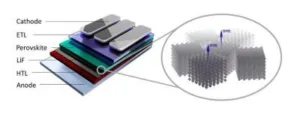A team of researchers led by Richard Friend of the Cavendish Laboratory at the University of Cambridge, (Cambridge, UK) and Dawei Di of the Department of Optical Science and Engineering at Zhejiang University (Hangzhou, P.R. China) are developing a technology to produce highly efficient perovskite-based LEDs and that also enables the incorporation of a wider range of materials into such LEDs than had previously been possible.

First, a little background information.
Two factors found to constrain the performance of visible light emitting perovskite-based LEDs are non-radiative recombination losses and the limited options available for suitable charge transport materials. Regarding the second issue, part of the reason for the difficulty in finding suitable materials is due to incompatibilities between the charge transporting layers and the perovskite deposition processes. More specifically, one appealing candidate hole transporting polymeric semiconductor material is called TFB. It is found to produce poor results due to the strong hydrophobicity of the polymer surface.
The approach adopted by the researchers to address these issues involved inserting a thin layer of lithium fluoride between the polymer hole transport layer and the perovskite layer. The fluoride layer served to hold the “sandwich like” multilayer device structure together and minimize the interfacial non-radiative energy losses in the LED.
A recent article on this topic by the authors is entitled “Efficient light-emitting diodes from mixed-dimensional perovskites on a fluoride interface.” It was published in Nature Electronics volume 3, pages 704 – 710 (2020). A copy of the article is available for purchase here.
The means by which the researchers implemented their new approach can be explained by paraphrasing this article. The first step was to prepare a perovskite precursor solution. The eventual control of the crystallinity and dimensionality of the perovskite layer was achieved by using tetraphenylphosphonium chloride as an additive. The researchers then used a spin coating process to deposit the hole transporting polymer TFB on a tin indium oxide coated glass substrate. This was followed by a thermal annealing treatment and the thermal evaporation of a thin lithium fluoride layer on the TFB surface.
The perovskite precursor solution was deposited on the lithium fluoride coated TFB. An organic electron transporting layer was then created via thermal evaporation. Finally, the researchers thermally evaporated lithium fluoride/aluminum contacts through a shadow mask and encapsulated the LED.
The structure of the LED featuring the mixed dimensional perovskite on a fluoride interface is illustrated in the figure below.
Structure of the LED featuring the mixed dimensional perovskite on a fluoride interface.
The researchers found that by using ultrathin fluoride interfacial layers (about 1?nm), it was possible to form and integrate highly luminescent perovskite layers into LED device structures. More specifically, the researchers report that it was possible to fabricate a green electroluminescence device having a high external quantum efficiency of greater than 19.1% at high brightness of greater than 1500 cd/m².
The team was able to draw several broad conclusion from their research. The first was that the highly polar dielectric interface acts as an effective template for forming high quality bromide perovskites on otherwise incompatible hydrophobic charge transport layers. A second was that the photoluminescence quantum efficiency of the perovskite films was related to the polarity of the chemical bonds in the interface upon which it was deposited. This result implies that the emission efficiency of the perovskite-based LED could be controlled just by changing the chemical properties of the substrate.
Looking towards future research, the team proposes investigations into means to further improve the light emission efficiency of perovskite LEDs by using mechanisms such as photon recycling. In addition, the team plans to work on blue perovskite LEDs and issues related to operational stability. -Arthur Berman
Zhejiang University, Dawei Di, [email protected]
University of Cambridge, Richard Friend, +44 (0)1223 337218, [email protected]

